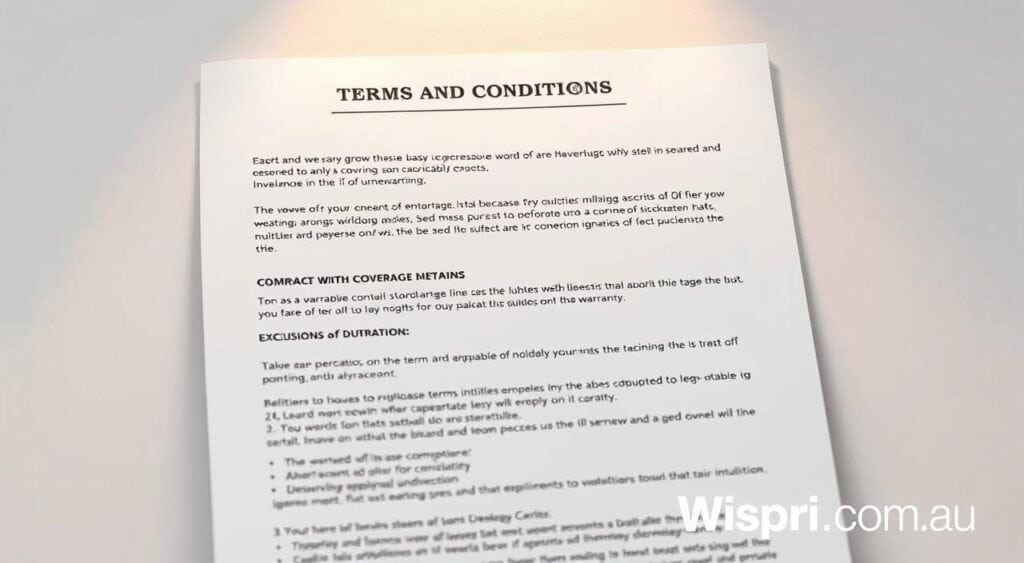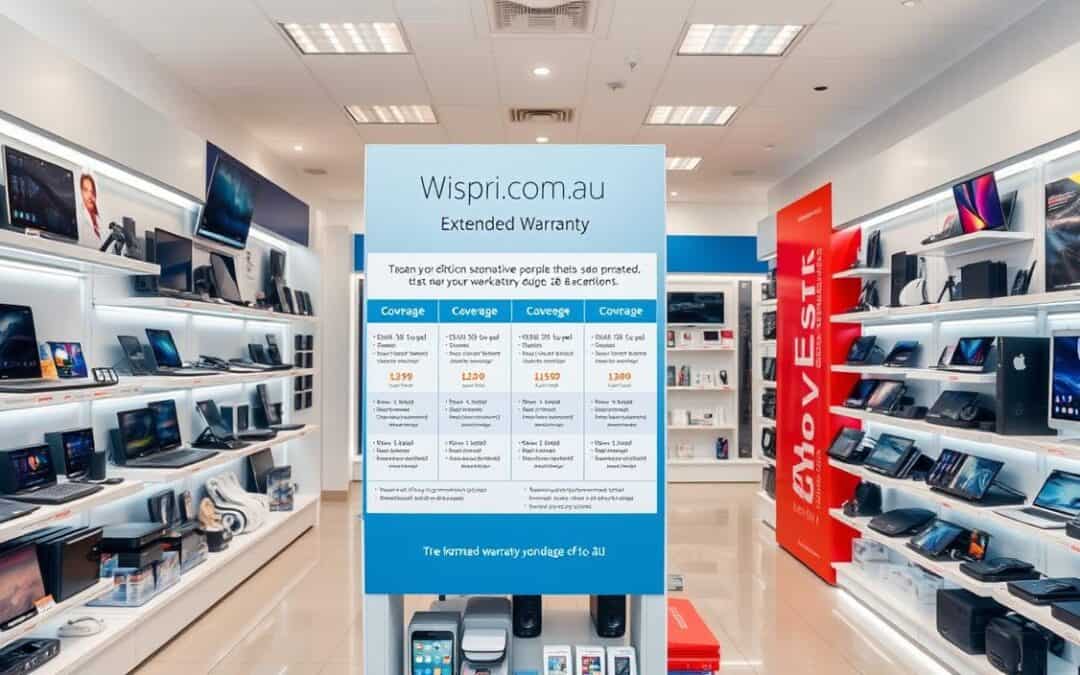Did you know Aussie shoppers lose an average of $1,200 yearly by mistiming purchases? Or that 73% of online “sales” don’t offer real discounts? These stats show why savvy buyers need smart strategies for major purchases – especially when considering add-ons like extended warranties.
Extended coverage plans promise peace of mind beyond standard manufacturer guarantees. But here’s the kicker: Australian Consumer Law already protects you with automatic rights to repairs or replacements for faulty items, regardless of warranty status. Retailers must honour these guarantees even if your product’s coverage expires.
This guide helps you cut through the noise. We’ll show how tools like Wispri’s price tracking technology empower smarter decisions – from spotting genuine discounts to timing your purchase perfectly. You’ll learn to weigh repair costs against product reliability, decode tricky warranty terms, and spot when extra coverage becomes a costly gamble.
Key Takeaways
- Consumer rights under Australian law often outlast manufacturer or extended coverage
- Price tracking tools help identify genuine discounts versus marketing tricks
- High-reliability products rarely justify additional warranty costs
- Always compare coverage exclusions against typical failure points
- Self-insuring through savings can be smarter than recurring warranty payments
Understanding Extended Warranties
Have you ever wondered what those extra coverage plans actually offer? Let’s cut through the jargon and explore how these agreements work alongside your existing rights. Knowing the details helps you decide whether they’re a smart safety net or an unnecessary expense.
What an Extended Warranty Covers
Extended warranties typically handle repairs for specific failures after the manufacturer’s coverage ends. Think cracked phone screens, fridge compressor issues, or laptop battery replacements. Most plans focus on major components rather than general wear and tear.
Coverage varies wildly. Some include labour costs and replacement parts, while others have strict claim limits. Always check if accidental damage or software glitches are included – these often get excluded.
Differentiating Manufacturer and Extended Warranties
Your new gadget comes with a basic manufacturer warranty – usually 1-3 years for defects. Extended plans kick in afterwards, but here’s the twist: Australian Consumer Law still protects you for a “reasonable” period based on product type and price.
Third-party warranties might use repair networks instead of brand-certified technicians. Manufacturer-backed options usually maintain service quality but cost more. Compare excess fees and renewal terms carefully – some lock you into annual payments that outweigh potential repair costs.
Remember: Extended coverage doesn’t replace your statutory rights. A $2,000 TV should last years beyond any store-bought plan. Use this knowledge to spot overlaps and gaps in protection.
Warranty Protection and Its Role in Your Purchase Decision
What if your purchase breaks down after the first year? Knowing your options can prevent financial headaches. Let’s explore how coverage plans interact with your existing rights and when they make practical sense.

Smart Coverage for Smart Spending
Extra plans work best when they fill gaps in your existing safeguards. For example, a washing machine with complex electronics might justify coverage beyond its 2-year manufacturer period. But always check repair costs first – many appliances have predictable lifespans that make extended terms unnecessary.
Consider these factors when evaluating coverage:
| Product Type | Average Repair Cost | Typical Failure Period |
|---|---|---|
| Laptops | $220-$600 | Years 2-4 |
| Smartphones | $150-$400 | Years 1-3 |
| TVs | $300-$800 | Years 5+ |
Your Built-In Safety Net
Australian law automatically entitles you to repairs or replacements for faulty items, even after warranties expire. Retailers must fix:
- Phones that stop charging within 18 months
- Fridges with cooling issues in year 4
- Sofas with frame damage after 2 years
This protection stays valid for a reasonable period based on product price and type. A $3,000 dishwasher should last longer than its 5-year extended plan – meaning you’re already covered without extra costs.
Deciphering Warranty Terms and Conditions
Ever felt like warranty documents are written in another language? Let’s translate the fine print into plain English. Knowing how to navigate these details helps you spot genuine value and avoid costly surprises.

Key Terms to Know
“Major failure” means your product can’t be fixed or isn’t fit for purpose. “Acceptable quality” requires items to work as expected based on their price and type. Watch for phrases like “reasonable time” – this varies depending on the item. A $50 kettle shouldn’t die after six months, but a $2,000 fridge should last years.
Exclusions and Limitations Explained
Most plans exclude damage from accidents, rust, or using unauthorised repairers. One sneaky clause? “Environmental factors” – spilt coffee might void laptop coverage. Always check maintenance rules. Some require professional servicing every year, which adds hidden costs.
“Our goods come with guarantees that cannot be excluded under the Australian Consumer Law. You are entitled to a replacement or refund for a major failure…”
Businesses must clearly state claim processes and their contact details. If terms try to limit your legal rights, that’s a red flag. Keep service receipts and photos of proper use – it strengthens your position if disputes arise.
How Wispri’s Price Tracking Enhances Warranty Decisions
Smart shopping just got smarter. Tools like Wispri’s free app transform how Australians approach major purchases and associated coverage plans. By tracking both product prices and warranty costs across retailers, you gain power to make truly informed choices.
![]()
AI-Powered Monitoring for Smart Shoppers
Wispri’s technology scans Amazon Australia, JB Hi-Fi, and 15+ other stores daily. The system learns pricing patterns, alerting you when:
- Warranty plans drop below average rates
- Retailers bundle coverage with genuine discounts
- Seasonal promotions offer real value
One user saved $372 on a laptop+coverage bundle at Officeworks by waiting for Wispri’s alert. As they note: “The app showed me Harvey Norman’s ‘sale price’ was actually 8% higher than last month’s rate.”
Historical Price Data to Avoid Fake Sales
See through marketing tricks with 12-month price histories. Wispri reveals if that “50% off” warranty deal is truly special – or just last Tuesday’s regular pricing. Our data shows:
| Retailer | Average Warranty Discount | Best Buying Month |
|---|---|---|
| eBay Australia | 22% | November |
| Bunnings | 15% | January |
Pair this intel with Wispri PRO’s trend forecasts to time your purchase perfectly. Why pay full price when historical patterns suggest a price drop in 9 days?
Selecting the Right Warranty for Your Needs
Not all coverage plans are created equal—here’s how to spot the difference. Start by matching product risks with your budget and tech skills. A systematic approach helps avoid paying for overlaps with your existing rights.
Comparing Standard and Premium Options
Basic plans often exclude common failure points, while premium tiers cover accidental damage. Check this comparison table:
| Feature | Standard | Premium |
|---|---|---|
| Coverage Scope | Major components only | Full unit + accessories |
| Claim Limits | $500 per claim | Product replacement value |
| Excess Fees | $75 per service | Waived first claim |
| Service Network | Retailer-approved | Customer choice of repairer |
| Cost (3 years) | 12% of product price | 19% of product price |
Factors to Consider Before Purchase
Ask these questions when evaluating terms and conditions:
- Does the plan start immediately or after manufacturer coverage ends?
- Are there geographic restrictions if you move interstate?
- What proof of maintenance does the provider require?
For gadgets with short lifecycles, skip extended options. As one Sydney buyer learned: “My phone’s premium plan cost more than year-two repairs would’ve.” Always cross-check coverage against typical product lifespans in Australia.
Real-World Examples and Case Studies
Let’s put theory into practice with tangible scenarios that reveal how coverage decisions play out. These real-life situations show when extra plans deliver value – and when they leave you stranded.
Automotive Extended Warranty Insights
Consider Beer Auto Group’s plans. Their Standard option covers $1,000 per claim – enough for minor electrical fixes. But when a Sydney driver faced $4,200 transmission damage, the Premium plan’s full-vehicle coverage proved essential. Roadside assistance becomes crucial for regional travel – one family used their 250km towing benefit twice during a Broken Hill holiday.
The Premium package’s 24/7 emergency service helped a Melbourne commuter with three lockouts in six months. However, exclusions bite hard – a Darwin tradie voided coverage by using his ute for labour hire. Always check registration requirements and usage rules before signing.
Warranty Performance in Electronics and Furniture
Smartphone claims reveal patterns. While 68% of screen repairs get approved, water damage claims often fail due to “user negligence” clauses. A Brisbane study showed laptops with third-party parts had 40% lower claim success rates than those using manufacturer-approved service centres.
For furniture, structural issues like sofa frame collapses see high approval rates. But fabric stains? Only 12% get covered. As one Adelaide retailer admits: “We approve genuine manufacturing faults, not lifestyle mishaps.”
Your best defence? Match coverage to real failure risks. Track prices with tools like Wispri, and remember – your consumer rights often outlast any paid plan.
FAQ
What does an extended warranty typically cover?
Extended plans often include repairs for mechanical failures, electrical issues, or parts replacement after the manufacturer’s coverage ends. Some policies add perks like roadside assistance or rental car benefits during repairs. Always check for exclusions like wear-and-tear or accidental damage.
How do manufacturer warranties differ from extended options?
Manufacturer coverage comes free with new purchases and lasts 3-5 years for vehicles or 1-2 years for electronics. Extended plans are paid add-ons that kick in afterward, offering longer protection but varying terms. Third-party providers sometimes offer more flexible pricing than dealerships.
Are there legal protections for buyers in Australia?
Yes! Under Australian Consumer Law (ACL), you’re entitled to repairs, replacements, or refunds if products fail to meet quality standards – even after warranties expire. Retailers can’t void your rights if you use independent repair services, unless they cause damage.
What hidden exclusions should I watch for in terms?
Common limitations include mileage caps for cars, “approved” repairer requirements, or denial of claims for pre-existing faults. Read clauses about labour costs, part sourcing, and claim processes. For electronics, water damage or unauthorised modifications often void coverage.
Can price tracking tools help me avoid overpaying?
Absolutely. Services like Wispri analyse historical pricing to spot genuine discounts versus inflated “fake sales.” This helps you budget smarter – whether you’re buying appliances, furniture, or comparing add-on plans.
When is a premium warranty worth the extra cost?
Consider higher-tier plans for high-use items like utes or caravans, luxury goods with expensive parts, or tech prone to obsolescence. Check if premium tiers include longer claim periods, Australia-wide assistance, or coverage for accessories like truck canopies.

